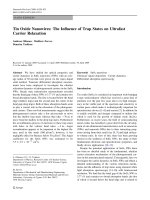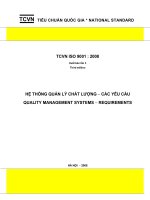Bài giảng Xử lý tín hiệu số: Chapter 3 - Hà Hoàng Kha
Bạn đang xem bản rút gọn của tài liệu. Xem và tải ngay bản đầy đủ của tài liệu tại đây (500.09 KB, 22 trang )
Chapter
p 3
Discrete-Time Systems
Ha Hoang Kha, Ph.D.Click to edit Master subtitle style
Ho Chi Minh City University of Technology
@
Email:
CuuDuongThanCong.com
/>
Content
Input/output
I
t/ t t relationship
l ti hi off the
th systems
t
Linear time-invariant
time invariant (LTI) systems
convolution
FIR andd IIR filters
fil
Causality
C
li and
d stability
bili off the
h systems
Ha H. Kha
2
CuuDuongThanCong.com
Discrete-Time Systems
/>
1. Discrete-time signal
The discrete-time signal x(n) is obtained from sampling an analog
signal x(t),
(t) i.e.,
i e x(n)=x(nT)
(n)= (nT) where
here T is the sampling period.
period
There are some representations of the discrete-time signal x(n):
x(n)
Graphical representation:
Function:
Table:
T bl
⎧1
⎪
x ( n) = ⎨ 4
⎪0
⎩
n
…
x(n) …
for n = 1,3
for n = 2
4
1
‐1
1
elsewhere
l
h
1
0 1 2 3 4
n
‐2
‐1
0
1
2
3
4
5
…
0
0
0
1
4
1
0
0
…
Sequence:
q
x(n)=[…
( ) [ 0,, 0,, 1,, 4,, 1,, 0,, …]=[0,
] [ , 1,, 4,, 1]]
Ha H. Kha
3
CuuDuongThanCong.com
Discrete-Time Systems
/>
Some elementary of discrete-time signals
Unit sample sequence (unit impulse):
⎧1
δ ( n) = ⎨
⎩0
for n = 0
for n ≠ 0
Unit step signal
⎧1
u ( n) = ⎨
⎩0
f n≥0
for
for n < 0
Ha H. Kha
4
CuuDuongThanCong.com
Discrete-Time Systems
/>
2. Input/output rules
A discrete-time system is a processor that transform an input
seq ence x(n)
sequence
(n) into an output
o tp t sequence
seq ence y(n).
(n)
Fig: Discrete-time system
Sample-by-sample
Sample by sample processing:
that is,
and so on.
Block processing:
Ha H. Kha
5
CuuDuongThanCong.com
Discrete-Time Systems
/>
Basic building blocks of DSP systems
Constant multiplier
p
Delay
D l
y (n) = ax(n)
x((n)
y ( n) = x ( n − D )
x(n
( )
x2 ((n
n)
Adder
dde
y (n) = x1 (n) + x2 (n)
x1 (n)
x2 ( n )
Signal multiplier
Ha H. Kha
x1 (n)
6
CuuDuongThanCong.com
y (n) = x1 (n) x2 (n)
Discrete-Time Systems
/>
Example
Let x(n)={1,
( ) { , 3,, 2,, 5}.
} Find the output
p and plot
p the graph
g p for the
systems with input/out rules as follows:
y( )
( )
a)) y(n)=2x(n)
b) y(n)=x(n-4)
c) y(n)=x(n)+x(n-1)
y(n)=x(n)+x(n 1)
Ha H. Kha
7
CuuDuongThanCong.com
Discrete-Time Systems
/>
Example
A weighted
g
average
g system
y
y(n)=2x(n)+4x(n-1)+5x(n-2).
y( )
( )
( )
( ) Given the
input signal x(n)=[x0,x1, x2, x4 ]
p y(n)
y( ) byy sample-sample
p
p p
processingg method?
a)) Find the output
b) Find the output y(n) by block processing method.
c) Plot the block diagram to implement this system from basic
building blocks ?
Ha H. Kha
8
CuuDuongThanCong.com
Discrete-Time Systems
/>
3. Linearity and time invariance
A linear system has the property that the output signal due to a
linear combination of ttwo
o inp
inputt signals can be obtained b
by forming
the same linear combination of the individual outputs.
Fig: Testing linearity
If y(n)=a1y1(n)+a2y2(n) ∀ a1, a2 Æ linear system. Otherwise, the
system is nonlinear.
Ha H. Kha
9
CuuDuongThanCong.com
Discrete-Time Systems
/>
Example
Test the linearity of the following discrete-time systems:
a) y(n)=nx(n)
b) y(n)=x(n2)
c) y(n)=x2(n)
d) y(n)=Ax(n)+B
Ha H. Kha
10
CuuDuongThanCong.com
Discrete-Time Systems
/>
3. Linearity and time invariance
A time-invariant system is a system that its input-output
characteristics do not change with
ith time.
time
Fig:
g Testingg time invariance
If yD(n)=y(n-D) ∀ DÆ time-invariant system. Otherwise, the
system is time-variant.
Ha H. Kha
11
CuuDuongThanCong.com
Discrete-Time Systems
/>
Example
Test the time-invariance of the following discrete-time systems:
a) y(n)=x(n)-x(n-1)
b) y(n)=nx(n)
c) y(n)=x(-n)
d) y(n)=x(2n)
Ha H. Kha
12
CuuDuongThanCong.com
Discrete-Time Systems
/>
4. Impulse response
Linear time-invariant (LTI) systems are characterized uniquely by
their impulse response sequence h(n), which is defined as the
response of the systems to a unit impulse δ(n).
Fig: Impulse response of an LTI system
Fig:
i Delayed
D l d impulse
i
l responses off an LTI
T system
Ha H. Kha
13
CuuDuongThanCong.com
Discrete-Time Systems
/>
5. Convolution of LTI systems
Fig: Response to linear combination of inputs
Convolution:
y (n) = ∑ x(m)h(n − m) = x(n) ∗ h(n) (LTI form)
m
y (n) = ∑ h(m) x(n − m) = h(n) ∗ x(n) (direct form)
m
Ha H. Kha
14
CuuDuongThanCong.com
Discrete-Time Systems
/>
5. FIR and IIR filters
A finite impulse response (FIR) filter has impulse response h(n)
that extend only over a finite time interval,
interval say 0 ≤n ≤ M.
M
Fi FIR impulse
Fig:
i
l response
M: filter order; Lh=M+1: the length
g of impulse
p
response
p
h={h0, h1, …, hM} is referred by various name such as filter
coefficients, filter weights, or filter taps.
FIR filtering equation: y (n) = h(n) ∗ x(n) =
M
∑ h ( m) x ( n − m)
m =0
Ha H. Kha
15
CuuDuongThanCong.com
Discrete-Time Systems
/>
Example
The third-order FIR filter has the impulse response h=[1, 2, 1, -1]
a) Find the I/O equation, i.e., the relationship of the input x(n) and the
output y(n) ?
b) Given x=[1, 2, 3, 1], find the output y(n) ?
Ha H. Kha
16
CuuDuongThanCong.com
Discrete-Time Systems
/>
5. FIR and IIR filters
A infinite impulse response (IIR) filter has impulse response h(n)
of infinite duration,
duration say 0 ≤n ≤ ∞.
∞
Fi IIR impulse
Fig:
i
l response
IIR filtering equation: y (n) = h( n) ∗ x(n) =
∞
∑ h ( m) x ( n − m)
m =0
The I/O equation of IIR filters are expressed as the recursive
difference equation.
Ha H. Kha
17
CuuDuongThanCong.com
Discrete-Time Systems
/>
Example
Determine the output of the LTI system which has the impulse
r p n h(n)=
response
h(n)=anu(n),
(n) |a|≤
| |≤ 1 when
h n th
the inp
inputt is
i the
th unit
nit step
t p signal
i n l
x(n)=u(n) ?
Remark:
m
n+
+1
1
r
−
r
k
r
=
∑
1− r
k =m
n
When n= ∞ and|r|≤ 1
Ha H. Kha
∞
m
r
k
r
=
∑
1− r
k =m
18
CuuDuongThanCong.com
Discrete-Time Systems
/>
Example
Assume the IIR filter has a casual h(n) defined by
for n = 0
for n ≥ 1
⎧ 2
h( n) = ⎨
n −1
4
(
0
.
5
)
⎩
a)) Find
Fi d the
h I/O difference
diff
equation
i ?
b) Find the difference equation for h(n)?
Ha H. Kha
19
CuuDuongThanCong.com
Discrete-Time Systems
/>
6. Causality and Stability
Fig: Causal, anticausal, and mixed signals
LTI systems can also classified in terms of causality depending on
whether h(n) is casual, anticausal or mixed.
A system is stable (BIBO) if bounded inputs (|x(n)| ≤A) always
generate bounded outputs (|y(n)| ≤B).
A LTI system is stable ⇔
∞
∑ | h( n) | < ∞
n = −∞
Ha H. Kha
20
CuuDuongThanCong.com
Discrete-Time Systems
/>
Example
Consider the causality and stability of the following systems:
a) h(n)=(0.5)nu(n)
b)) h(n)=-(0.5)
( ) ( )nu(-n-1)
(
)
Ha H. Kha
21
CuuDuongThanCong.com
Discrete-Time Systems
/>
Homework
Problems: 3.1, 3.2, 3.3, 3.4, 3.5, 3.6
Ha H. Kha
22
CuuDuongThanCong.com
Discrete-Time Systems
/>









